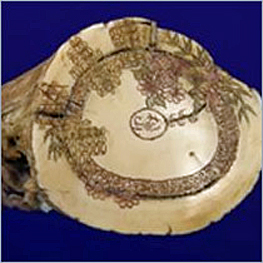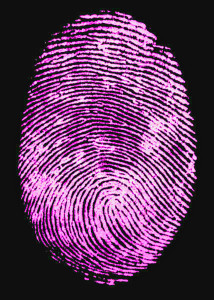The News Blog is on hold for now. In the meantime, please enjoy the archive.
Author Archives: admin
Exposing Fingerprints
During July, the University of Leicester Press Office posted a report about a new technique for visualizing latent fingerprints from crime scenes. Visualizing usable latent fingerprints poses a challenge; about 10% of crime scene fingerprints have sufficient quality to be used as evidence during a trial.
The new technique exposes fingerprints by using the electrically insulating properties of a fingerprint’s sweat and oil deposits. The chemicals in a fingerprint block an electric current used to deposit a colored, electro-active film. The deposited film collects on the surface between fingerprint deposits to create a negative image of the fingerprint. The technique is very sensitive and can be used in combination with traditional visualization techniques, such as fingerprinting powders.
“By using the insulating properties of the fingerprints to define their unique patterns and improving the visual resolution through these color-controllable films,” said team leader Professor Robert Hillman in a press release, “we can dramatically improve the accuracy of crime scene fingerprint forensics. From the images we have produced so far, we are achieving identification with high confidence using commonly accepted standards.”
Animal Forensics

Mastodon or mammoth tusk used as an ivory substitute for ivory from a living species. Source: US Fish and Wildlife Service.
A 2012 report by the Convention on International Trade in Endangered Species warned that elephant poaching has reached its highest level since record keeping started a decade earlier. This, despite the 1989 international ban on the trade of new ivory. Currently, about 30,000 African elephants are killed every year. Around 400,000 African elephants still exist.
The international ban allows the trade of ivory acquired before 1989. The trick has been to distinguish between old, legal ivory and new, poached ivory. Kevin Uno, a researcher at Columbia University’s Lamont-Doherty Earth Observatory is the lead author on a report that describes a technique for determining the age of ivory.
“We’ve developed a tool that allows us to determine the age of a tusk or piece of ivory, and this tells us whether it was acquired legally,” Uno said in a press release. “Our dating method is affordable for government and law enforcement agencies and can help tackle the poaching and illegal trade crises.”
You can find details about the ivory trade problem and the new technique at Columbia University’s Lamont-Doherty Earth Observatory website.
Speaking of animal forensics, NPR recently posted Rhitu Chatterjee’s article about Carla Dove, an ornithologist and a forensic expert. Working in a forensics lab at the Smithsonian Museum of Natural History, Dove identifies birds from feathers and bone fragments. Her work is quite varied – from identifying birds that collide with airplanes to identifying avian prey of giant Burmese pythons slithering in Florida’s Everglades. Chatterjee’s article is a good starting point for an overview of the field of forensic ornithology.
Decaying Credibility of Bite Mark Evidence
 The Associated Press’ Amanda Myers wrote a very interesting article about problems with bite mark impression evidence. “A small, mostly ungoverned group of dentists carry out bite mark analysis,” Myers wrote, “and their findings are often key evidence in prosecutions, even though there is no scientific proof that teeth can be matched definitively to a bite into human skin.”
The Associated Press’ Amanda Myers wrote a very interesting article about problems with bite mark impression evidence. “A small, mostly ungoverned group of dentists carry out bite mark analysis,” Myers wrote, “and their findings are often key evidence in prosecutions, even though there is no scientific proof that teeth can be matched definitively to a bite into human skin.”
The Associated Press analyzed court records to learn the number of those who have been exonerated after they were convicted or charged based on bite mark evidence. The results of the study: Since 2000, at least 24 men have been exonerated. Bite mark evidence had thrown one man in prison for more than 23 years.
The validity of bite marks as evidence depends upon two assumptions. First, teeth leave recognizable marks unique to an individual. Second, this uniqueness is transferred and recorded in the bitten substance. Critics argue, however, that neither assumption is supported by scientific studies.
“Bite mark evidence is the poster child of unreliable forensic science,” Chris Fabricant told Myers. Fabricant is the director of strategic litigation at the Innocence Project.

